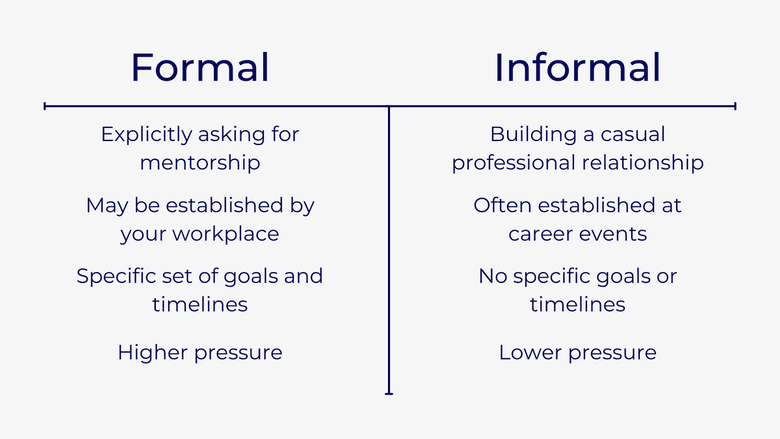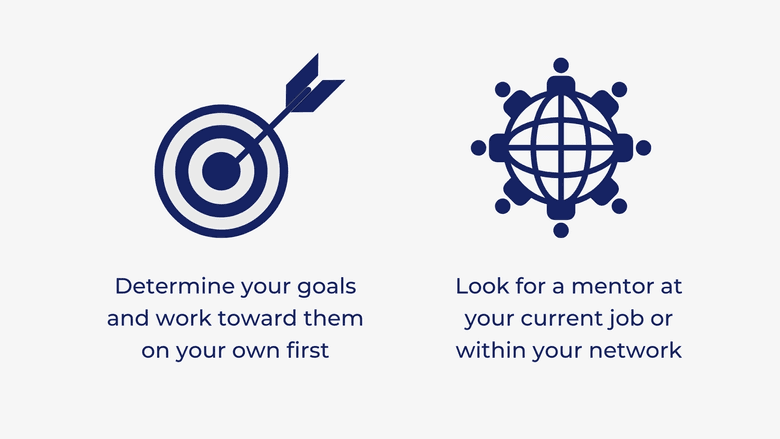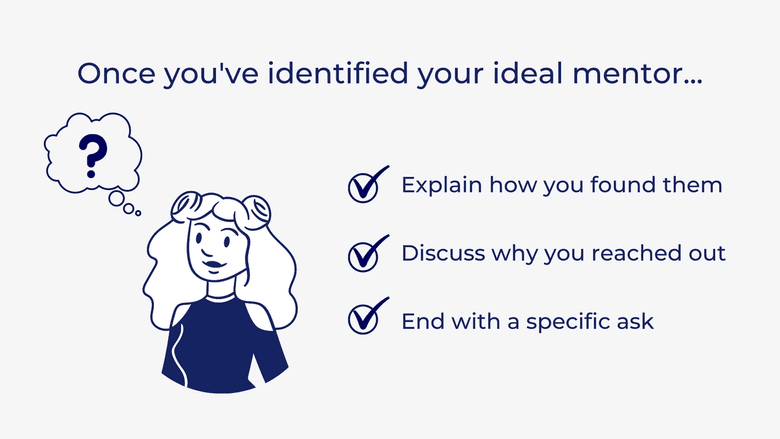4 Tips for Finding the Right Mentor
Finding a great mentor can transform your career. Here’s the lowdown on how to start the relationship.
Imagine having a seasoned professional take you under their wing, offering you an insider’s perspective on your chosen industry, providing constructive criticism on your portfolio and resume, and checking in with you periodically as you work towards that job offer or promotion. Perhaps they even offer to put in a good word for you with the hiring manager. This is the role of the mentor, an experienced person who helps less experienced people with their professional and personal development.
While the above represents a best-case scenario for a mentor-mentee relationship, receiving mentorship from someone whose work or personal brand you admire can transform your career. It can lead to a new job, a raise or simply bring greater satisfaction in your current role.
Types of Mentorship: Formal vs. Informal

Formal Mentorship
Mentoring relationships can be formal or informal. In a formal mentorship, you expressly ask someone to mentor you. Then, you create a set of goals for the relationship, a start and end date, and periodic check ins. When you meet, you might ask for advice or review specific items, such as your cover letter or a project you’re working on.
Sometimes, these relationships are established by your workplace. For example, senior software engineers customarily mentor several junior developers simultaneously. The exchange is mutually beneficial: mentees gain wisdom from the mentor’s knowledge and expertise, while the mentor hones their mentoring, problem solving, and communication skills.
Informal Mentorship
If you’re seeking a mentor for the first time, you may feel more comfortable starting informally. Perhaps you meet a product manager you admire at a networking event. You introduce yourself and tell them what you admire about their work. After the event, follow up with an email telling them you enjoyed the conversation, and ask to meet for coffee or an informational interview. The relationship may progress naturally over time—send them interesting articles every now and then, update them on your progress and ask for their advice with specific career moves.
Once you’re comfortable with each other, you can formally request that they become your mentor. Starting off informally removes the pressure from both of you; if they’re comfortable with you, they won’t feel obligated to say ‘yes’ and you won’t feel as though you are asking for too much.
Before Looking for a Mentor, Do Your Homework
You should have a specific reason for seeking mentorship. Never expect a mentor to help you find a job. Rather, consider them a guiding light for your professional development. The more specific you are with your career goals, the more likely you are to find the right person.
1. Define Your Career Goals

Start by defining what you want out of your career—a job at your dream company, a promotion or a career change—and what’s standing in your way. Some examples include:
- Gaining a specific skill set (e.g. leadership skills)
- Getting more callbacks for job interviews
- Vouching for yourself in the workplace or asking for a promotion/raise
- Figuring out the next steps in your current career path
- Breaking into a new industry
- Expanding your professional network in a specific region or industry
Envisioning your dreams this way allows you to break down lofty ideals into bite-sized goals. Before you search for a mentor, think about actions you can take to get closer to these goals on your own. It’s not necessary for you to have all the answers, but the more effort you’ve put into furthering your career by the time you meet your mentor, the more useful their advice will be. For example, perhaps you start an online course in data analytics to supplement your knowledge gaps. This way, you can rely on your mentor for job search advice rather than expecting them to teach you the fundamentals.
Where to find a mentor
The easiest way to find a mentor is to ask your superiors at your current company. Your immediate supervisor may already provide mentorship in some capacity. But if you don’t see a future with your current company or you’re dying to switch careers, look elsewhere. Start with your existing professional network, such as former bosses or coworkers, a helpful college professor or your alumni network.
Failing that, LinkedIn is a common platform for finding a mentor. Try to find someone who is a second- or third-degree connection, or at least works in the same industry or region. Having basic common ground is a major factor in establishing trust for a cold outreach. Look through your coworkers' LinkedIn connections for potential mentors, and ask if they can introduce you.
2. Set an Objective for the Relationship

Your objective should not be “get a job at Company X because so-and-so works there.” It's important to build this relationship on mutual respect, and nobody wants to feel used. Instead, give the impression that you value their unique expertise. Find someone who is like you, with a similar set of strengths and skills you want to emulate. Perhaps you’re wondering how to switch from software engineer to data engineer, so you reach out to someone who’s made the jump.
Once you’ve shortlisted potential candidates, research your prospective mentor. What articles have they published recently? What interesting or important roles have they held? Read through their latest LinkedIn posts to get a sense of what’s currently top of mind in their professional life. Find as much information as you can on the company they work for—what are their recent challenges and successes? This will help you be specific and honest about why you’re interested in their work and offer authentic praise.
If you decide to contact someone without a referral or prior connection, use social media to make yourself known to them for at least two weeks prior to sending your first cold email. Comment on their LinkedIn status updates, share their articles or like their tweets. If they don’t maintain a social media presence, look up their personal website and reference a project you liked. Doing so helps establish trust and signals you’re genuinely interested in their work.
3. Ask Them on a “First Date”

Even if you’re angling for a formal mentor relationship, start with a laid back approach and let the relationship develop. The most effective mentoring comes once the other person feels they have a personal stake in your success.
If you cold email someone, don’t mention the word ‘mentorship.’ Simply ask to meet for coffee or a 15-minute Zoom call. A helpful way to start an interaction is by asking insightful follow-up questions regarding their most recent blog post or speaking engagement. Use an unexpected email subject line, such as referencing a recent project (eg: “Inspired by your research on XYZ.”). Here are a few more tips to land a "first date" with the best mentors.
Let the person know how you found them
Perhaps a mutual acquaintance recommended you reach out to them (if you can name-drop, do so!), or you’ve admired their work for awhile and found them on LinkedIn. This step is very important so as to establish trust.
Be clear about why you’re reaching out
Don’t just say “I’d love to pick your brain on UX design.” Briefly explain why you’re passionate about this field, where you are in your career, and why you feel their advice is instrumental in helping you take the next step. A prospective mentor wants to know you have a roadmap and are willing to put in the work, and that you’re not simply angling for an introduction to their boss.
Close with a specific request
Keep the email short and end with a specific ask, like an informational interview. If you’ve never met, consider starting with a no-strings-attached phone call.
Prepare talking points ahead of your first meeting
Study up on industry lingo and what’s trending. What’s the latest technology stack software engineers are buzzing about? How do data scientists feel about autoML? This ensures you don’t waste your expert’s time asking Google-able questions. While you should come prepared with questions, let the conversation flow naturally, and follow the other person’s lead. If they’re formal and buttoned-up, follow suit. If they’re casual, don’t try too hard to stick to an agenda.
4. Make It “Official”

Follow up immediately with an email thanking them for their time. Mention one or two elements of your conversation that you found especially helpful. Think about whether you clicked with this person and want to spend more time with them. It’s essential that you and your mentor like each other because you’re investing in each other’s success.
Did this person show interest in your career trajectory? Did they seem willing to offer an insider’s perspective, or were they rather secretive? Even if this person has your dream job, don’t force a relationship if you don’t see eye-to-eye.
If you wish to proceed...
Tell them you’d like to meet again
Phrase this in an open-ended fashion, such as “I would love to meet with you again sometime. Perhaps I can get on your calendar for next month?” If they respond in kind, lock down a specific time. A vague response doesn’t necessarily mean they aren’t interested; they’re probably just busy. Send a follow-up email after a week or so requesting a specific time.
Create an agenda for your next meeting(s)
If you decide on a formal relationship, mention how often you’d like to meet (eg: once a week or once a month for six months) and how long each meeting should last. Mention you’ll put together agendas prior to each meeting that align with the goals you discussed. Perhaps you need feedback on a project you’re working on or advice on asking for a promotion. Be clear on what you’re working towards and how they can help you.
Decide on an end date
Let them know they aren’t obligated to you forever. A good rule of thumb for a mentor relationship is 4-6 months, with the option to continue meeting informally.
The information provided herein is for general informational purposes only and is not intended to provide tax, legal, or investment advice and should not be construed as an offer to sell, a solicitation of an offer to buy, or a recommendation of any security by Candor, its employees and affiliates, or any third-party. Any expressions of opinion or assumptions are for illustrative purposes only and are subject to change without notice. Past performance is not a guarantee of future results and the opinions presented herein should not be viewed as an indicator of future performance. Investing in securities involves risk. Loss of principal is possible.
Third-party data has been obtained from sources we believe to be reliable; however, its accuracy, completeness, or reliability cannot be guaranteed. Candor does not receive compensation to promote or discuss any particular Company; however, Candor, its employees and affiliates, and/or its clients may hold positions in securities of the Companies discussed.
